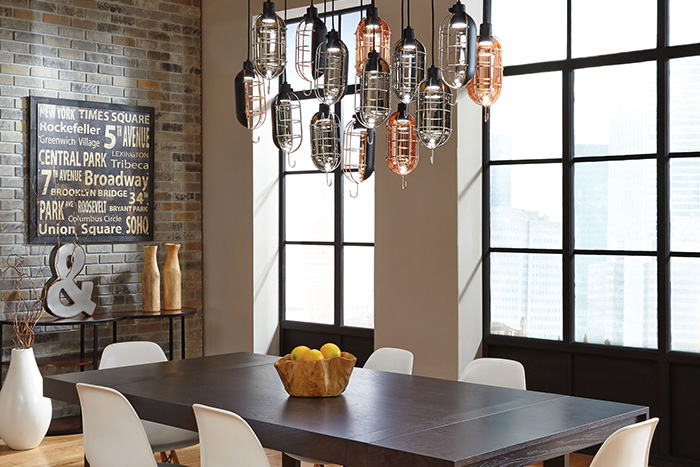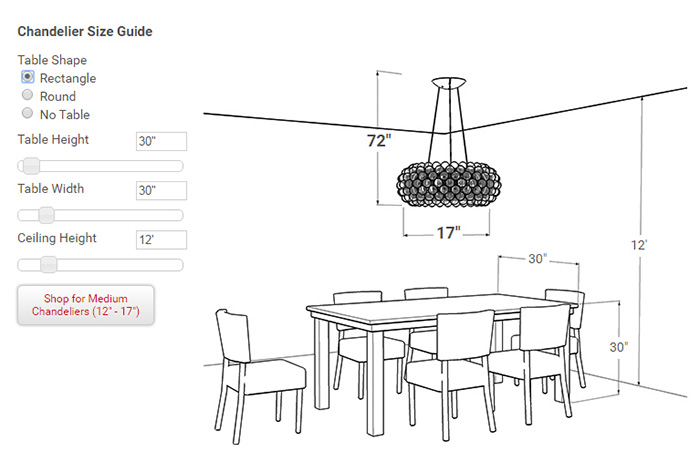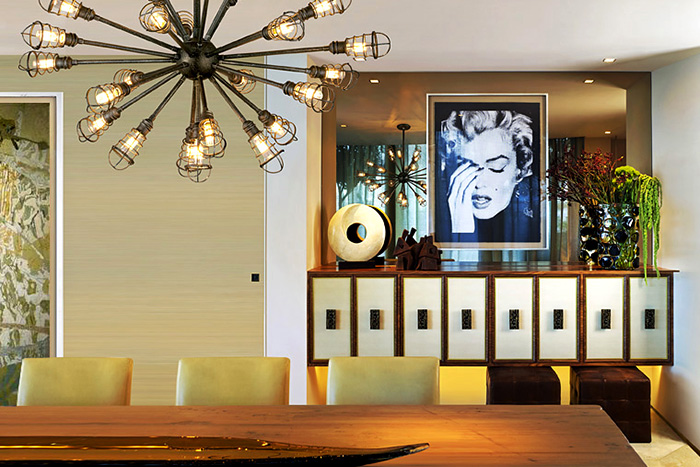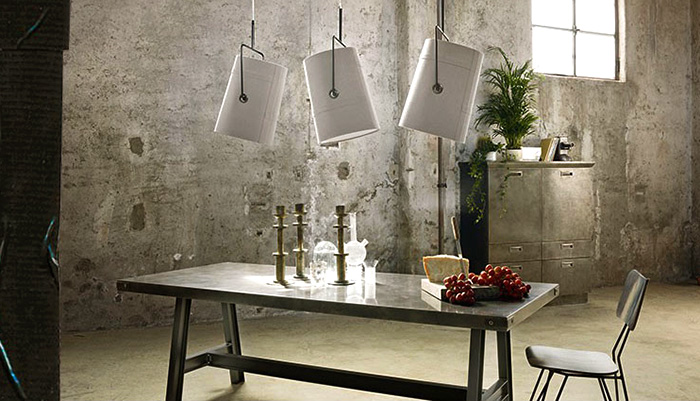How to Light a Dining Room Without a Chandelier

1. What are the basics of dining room lighting?
The first things you need to consider are the scene you want to create, the emotion you are looking for, what kind of lighting will complement your personal style, and your home's existing décor. You also want to make sure you have enough light on the table, walls, and artwork while avoiding glare. The dining room is not just for eating – it's a multi-functional space, used for homework, paying bills, playing games, and other tasks. Providing sufficient light at the table and around the room is key.
2. How can I create balanced light in my dining room?
A lone chandelier or pendant rarely achieves adequate lighting in any room. You can hang a chandelier over a dining room table and call it a day, but try and remember to create layers of light.
You want to provide general lighting as well as accent lighting. Recessed or track and monorail lighting are perfect in most dining rooms. Monorail, recessed, and track lighting allow you to feature certain architectural elements of your space as well as bring focus to your art work. This allows the room visual interest and prevents the space from feeling "flat." If you don't have any art to light, use wall sconces to take the place of art and add indirect lightning to the space.
For more information, read Recessed Lighting Basics and our Monorail Lighting Guide.
Last, provide lighting over the table for eating and drinking. A chandelier or light fixture that is to scale with the dining room table will light the seating area nicely.

3. Do I need to think about dimmers?
Yes. Dimmers are a great way to reduce glare, incandescent or halogen bulbs create a warm glow, and make a cozy atmosphere. If LED is what you are looking for, there are a few warm LED bulbs on the market today. On a separate dimmer, install wall and accent lights. On the technical side of things, if your fixture is halogen or LED, be sure that the dimmer matches the power supply.
» Read our Lighting Controls – Dimming article for more information.
4. Does the shape of the table matter when I'm considering a fixture?
Somewhat. A chandelier, pendant/suspension, or non-linear multi-pendant light fixture make sense over a round table. A linear suspension or linear multi-pendant light fixture make sense over a rectangular table.
While you wouldn't want a linear light over a round table, you could use two round lights over a rectangular table. You can also center a round fixture over a rectangular table and place a recessed downlight on each side. A nice monorail system with small pendants would be attractive over a rectangular table, as well.
Whichever fixture you place over your table, be sure to add soft general lighting to provide a flattering, warm background and a more comfortable atmosphere.

5. What size chandelier do I need over my dining room table?
The size of the chandelier will on depend on the size of the room and the width or diameter of the table. If the room is less than 10 feet wide, a chandelier less than 24 inches will be more comfortable and appealing. Of course, larger rooms and larger tables can accommodate larger chandeliers. Use our handy chandelier size calculator to get sizing estimates.
» You can also read How to Choose a Chandelier for more information.
6. I want a big chandelier or suspension for my dining room, but I don't think my ceiling is tall enough, what type of fixture would still give a "grand" appearance?
We have a wide selection of ceiling semi-flush lights that can easily accommodate lower ceilings and offer unique, impressive design without crowding the room. These lights are versatile as well as functional, and they give your dining room the space it requires.

7. I throw a lot of dinner parties. What type of fixtures(s) and bulbs will create the warmest glow?
A chandelier or suspension that uses incandescent bulbs typically has a warm, 2700K color temperature before dimming. Dimming a halogen or incandescent light bulb causes the color temperature to decrease and the bulb emits an even warmer, amber glow.
When shopping for LED chandeliers or when using LED replacement bulbs in an incandescent fixture, you should usually look for LEDs in the range of 2400K – 2700K. This will give you the cozy feel you're looking for. Keep in mind that most LEDs actually become cooler in color temperature when dimmed (the opposite of incandescent and halogen lighting), but this is slowly changing. There are several warm dimming LEDs on the market now that replicate the incandescent light bulb's familiar dimming behavior.
Before you do pick your bulb, do a quick survey of your dining room—paint colors and finishes make a difference. If you have dark walls or a dark ceiling, you will need more light (more watts) because dark colors absorb light. If you have warm earth tone colors like brown, red, yellow or amber match it with 2400K-2700K bulb. On the other hand, if you have cooler colors like purple, blue-green or blue make sure to go with a bulb in the 3000K range or higher. Choosing the right bulbs will accent the color of the room and enrich it.
8. The fixture in my dining room right now creates glare, how can I change that?
Glare is a common problem that kills ambiance in many dining rooms. Often times a simple adjustment of the fixture will do the trick. Most glare issues stem from the aim of the bulb. If you have recessed lighting, another solution is to change the trim to a raised or adjustable one, concealing the bulb a little more, and decreasing the glare. Lastly, you can install a dimmer.

9. How do I know what finish will look best in my space?
Take a look around your dining room and use the surrounding finishes as your guide. What material is the floor made of? What kind of window treatments do you have? What other metal finishes are in the room? Keep the finish and the style of the table in mind, as well.
10. My electrical outlet is not center over the table, what can I do?
This happens all the time, and fortunately it is an easy fix. Your first option is to install a swag hook, meaning a hook will be installed over the center of the table to suspend the cord from the junction box to the swag hook. Some do not like a hanging cord in the dining room, and in this case you can do what is known as a hide-a-cord, which conceals the cord.
If you don't want to do a swag hook, monorail lighting systems are another great option. Monorail provides multiple design options – hang pendants over your dining table without worrying about the location of the outlet.
» Read our chandeliers article for more information on how to swag a chandelier.
» Read our Monorail Lighting "How To" for more information.
How to Light a Dining Room Without a Chandelier
Source: https://www.lightology.com/index.php?module=how_to&sub=dining_room_lighting_ideas
0 Response to "How to Light a Dining Room Without a Chandelier"
Post a Comment